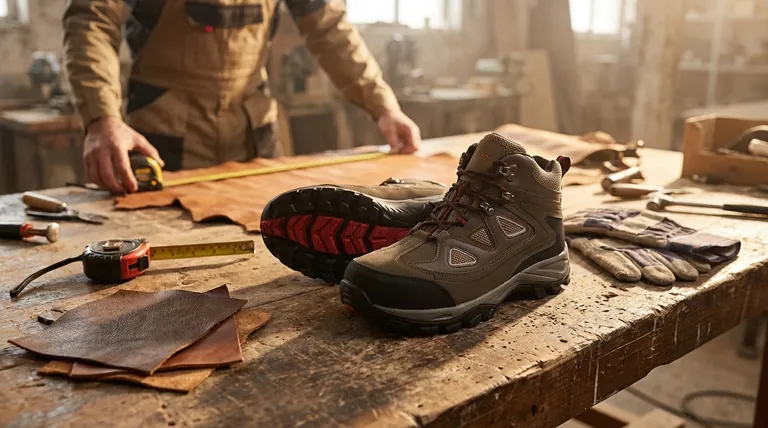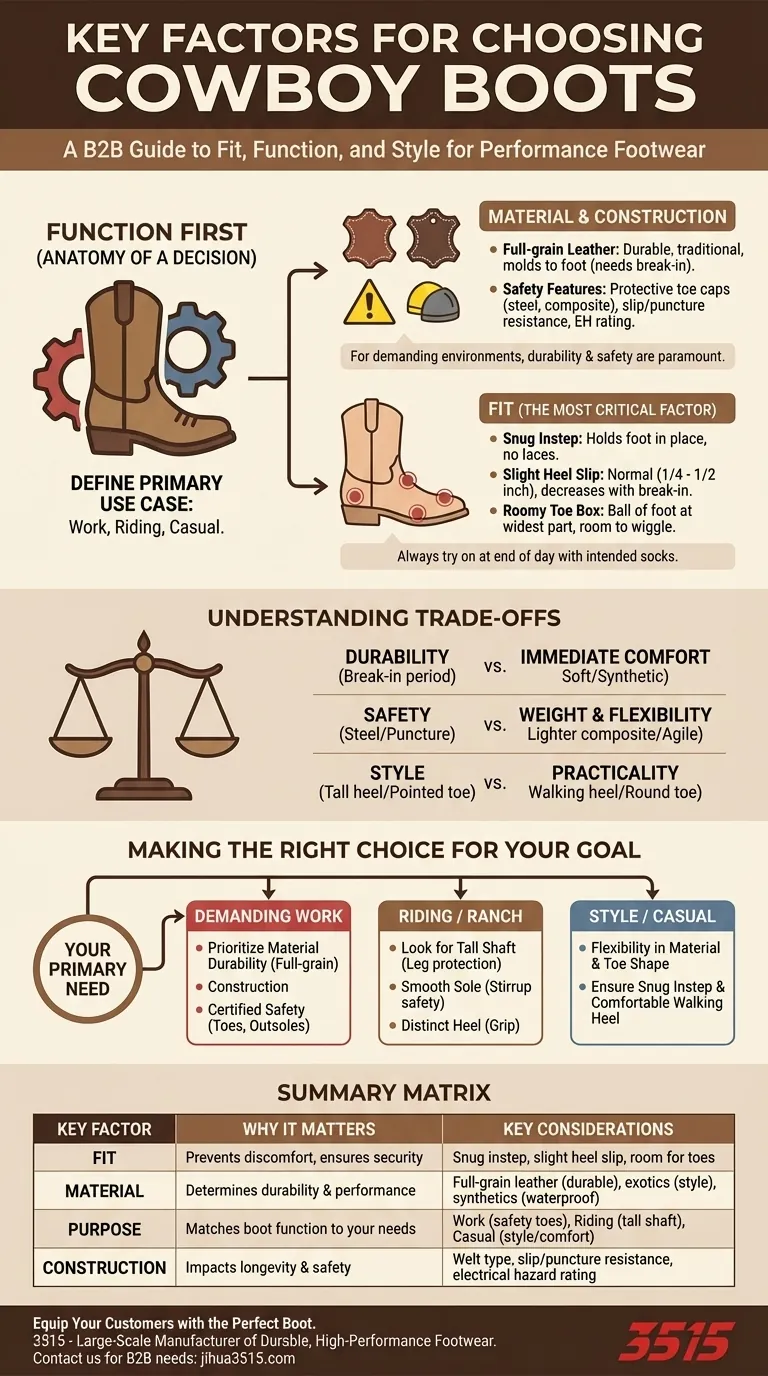In choosing cowboy boots, the most critical factors are ensuring a precise fit, matching the boot's material and construction to your intended use, and selecting a style that meets your needs. A proper fit prevents discomfort, while the right materials ensure the boot performs correctly, whether on a ranch, in a workshop, or for casual wear.
The core decision in selecting a cowboy boot isn't just about style; it's a calculated choice that balances the boot's intended function (work, riding, or fashion) with the essential, non-negotiable requirement of a proper fit.

The Anatomy of a Good Decision: Function First
Before you can evaluate any boot, you must first define its primary purpose. A boot designed for a construction site is fundamentally different from one made for a rodeo or a night out.
Defining Your Primary Use Case
The most common mistake is buying a boot for its looks without considering its functional design. This often leads to discomfort and premature wear.
Ask yourself: will this be a workhorse or a showpiece? Will you be on your feet for hours, in hazardous environments, or simply walking from your car to an office?
Material: The Foundation of Performance
The material dictates the boot's durability, breathability, and resistance to the elements.
Full-grain leather is the traditional and most durable choice, excellent for both work and classic style. It molds to your foot over time but requires a break-in period.
Other materials, like exotic skins (e.g., ostrich, alligator), offer unique aesthetics but may require more delicate care. Synthetic materials can provide specific benefits like waterproofing but often lack the breathability of genuine leather.
Construction and Safety Features
For demanding environments, construction is paramount. Look for features like protective toe caps (steel, composite, or alloy) if you work around heavy or rolling objects.
Slip and puncture resistance are crucial in workshops or outdoor settings. Electrical hazard (EH) rated boots are a necessity for anyone working near live circuits.
Fit: The Most Critical Factor
An ill-fitting cowboy boot is useless, no matter how well-made or stylish it is. The unique shape of a boot means fit is more nuanced than with other footwear.
How a Cowboy Boot Should Feel
A new boot should feel snug across the instep (the top of your foot). This is what holds your foot in place, as there are no laces.
Your heel should have a slight, intentional "slip" of about a quarter to a half-inch when you walk. This is normal and will decrease as the leather sole breaks in and flexes with your foot.
The ball of your foot should sit comfortably at the widest part of the boot. Your toes should have room to wiggle and should not feel cramped or pressed against the front.
The Importance of Trying Them On
It is highly recommended to have your feet professionally measured. Sizes vary between brands, and the shape of the boot's last (the mold it's built on) can drastically change the fit.
Always try on boots at the end of the day when your feet are slightly swollen. Wear the same type of socks you plan to wear with the boots regularly.
Understanding the Trade-offs
Choosing the right boot always involves balancing competing priorities. Understanding these compromises is key to making a decision you won't regret.
Durability vs. Immediate Comfort
The toughest, most durable full-grain leather boots often require a significant break-in period. Softer leathers or synthetic materials might feel comfortable out of the box but will not offer the same long-term resilience.
Safety vs. Weight and Flexibility
Features like steel toes and puncture-resistant soles add invaluable protection but also increase the boot's weight and rigidity. For jobs that require constant walking or agility, a lighter composite toe might be a better compromise.
Style vs. Practicality
A tall heel and a narrow, pointed toe might look sharp but are impractical and uncomfortable for all-day wear on hard surfaces. A lower, "walking" heel and a rounded or square toe are far more functional for daily use.
Making the Right Choice for Your Goal
Filter your options based on your primary need to avoid being overwhelmed by choice.
- If your primary focus is demanding work or safety: Prioritize material durability (full-grain leather), construction (welt type), and certified safety features like protective toes and slip-resistant outsoles.
- If your primary focus is riding or ranch work: Look for a taller shaft to protect your leg, a smooth leather sole that won't get stuck in a stirrup, and a distinct heel to prevent your foot from sliding forward.
- If your primary focus is style and casual wear: You have more flexibility with materials and toe shape, but a proper fit across the instep and a comfortable walking heel remain essential for all-day comfort.
Ultimately, the best cowboy boot is the one that serves its purpose while fitting your foot correctly.
Summary Table:
| Key Factor | Why It Matters | Key Considerations |
|---|---|---|
| Fit | Prevents discomfort; ensures security | Snug instep, slight heel slip, room for toes |
| Material | Determines durability & performance | Full-grain leather (durable), exotics (style), synthetics (waterproof) |
| Purpose | Matches boot function to your needs | Work (safety toes), Riding (tall shaft), Casual (style/comfort) |
| Construction | Impacts longevity & safety features | Welt type, slip/puncture resistance, electrical hazard rating |
Ready to Find Your Perfect Cowboy Boot?
As a large-scale manufacturer, 3515 produces a comprehensive range of durable, high-performance footwear for distributors, brand owners, and bulk clients. Our production capabilities encompass all types of work, riding, and casual boots, ensuring you get the right combination of fit, function, and style.
Let us help you equip your customers with the perfect boot for their needs.
Contact 3515 today for your manufacturing needs!
Visual Guide

Related Products
- Safety Footwear Wholesale Manufacturer for Custom OEM/ODM Production
- Wholesale Safety Footwear Manufacturer for Bulk & Custom OEM Orders
- Premium Grain Leather Safety Boots for Bulk Supply
- Premium Wholesale Waterproof Safety Boots High Performance Protection for Industrial Markets
- Customizable Anti-Smash Safety Boots for Wholesale & Private Label Manufacturing
People Also Ask
- What are OSHA approved shoes? Understanding the Correct Standards for Workplace Safety
- What are the differences between steel toe, composite toe, and alloy toe Wellington boots? Choose the Right Safety Toe for Your Job
- Is it normal to wear shoes in the house? A Guide to Hygiene, Comfort & Culture
- What do heavy duty boots do? Protect Your Feet in Demanding Work Environments
- What are the cultural perspectives on wearing shoes in the house? A Guide to Home Etiquette & Hygiene



















